Buy the ultimate Mahurangi Regatta marquee, now !
author Cimino
published as a work in progress 20231108–
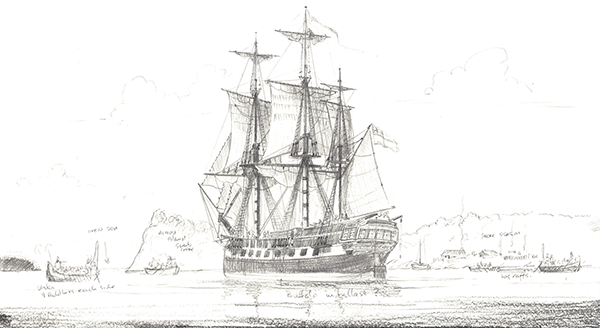
Not Auckland’s First Regatta: While the arrival of the hmss Buffalo in the vicinity of Spar Station Cove could, putatively, made for the first Mahurangi Regatta, the claim that can be substantiated is the enterprise was the first Pākehā settlement in the Auckland region, preceding acting-governor Hobson’s arrival in the Waitematā Harbour by eight yearsnominally eight. If something resembling a regatta did take place in 1834—between the spar station and the storeship’s boats, and the waka taua—it would most likely have been down harbour from this location, where its first mate and chartmaker, F A Cudlip, indicated the storeship anchored—with more generous rode.
modello Paul Deacon
In the wholly unlikely event that Mahurangi had served a period as New Zealand’s capital, after its potential suitability had been assessed for that purpose, the harbourscape of Auckland’s best kept secret would, today, be predominantly urban. In glorious contrast to that counterfactual, it is the verdant backdrop for one of the world’s visually richest regattas. But not only is the backdrop undespoiled, the sandy coastal terraces on either shore that accommodate the regatta shoreside events are in public ownership, as regional parkland.
Were it a commercial event and an admission fee charged, the Mahurangi Regatta, on the face of it, would be a far less challenging affair to organise. Commercialisation of the event, however, would rob it of much of its charm, not to mention exacerbate the erosion of the egalitarianism that was once a proud—albeit, imperfect—New Zealand attribute. It would also introduce mass of clashes and contradictions with the free regional park access that Aucklanders, appropriately, embrace as their birthright. In short, commercialising the Mahurangi Regatta is, mercifully, a non-starter. Nor, however, is a non-commercial Mahurangi Regatta light on the helm.
Traditionally—attracted by the civilised charm of the music and dancing that followed the racing—women leavened what might otherwise have irreversibly calcified into a blokes-and-their-boats regatta. Latterly, until World War II put the regatta into obeyance, the prize-giving dance had been held in the Waiwera Gaity Hall—Waiwera’s wharf having out-survived that at Scotts Landing. When Mahurangi Actionestablished 1974 as Friends of the Mahurangi revived the regatta in 1977, no thought was given to simultaneously reviving the after-match function. Styled as a good old-fashioned, leave-your-wallet-at-home picnic regatta, it was family-friendly through and through. Only when the 2004 Mahurangi Regatta Ball—held as the grand finale to Warkworth’s 150th anniversary events—was it immediately apparent how much of the traditional regatta had been missing. But far better than a ball—from which regatta-goers who’d missed the memo had, apologetically, to be turned away—an allcomers-welcome, lower-key prize-giving dance was clearly the preferable, not to mention equitable , solution.
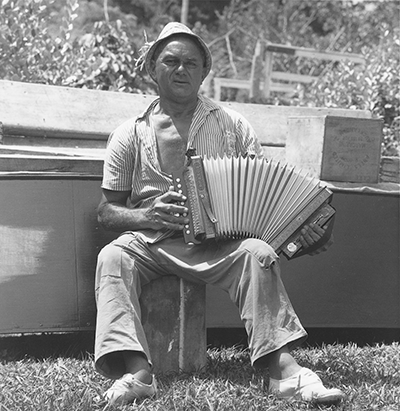
Prize-Giving Dance Revival Inspiration: Storied storyteller Frederick Beau Jackson, and at least one brother, were amongst the musicians who played for the Mahurangi Regatta Prize-Giving Dance in the Waiwera Gaiety Hall in the period prior to the regatta lapsing, during World War II. Visitors to the Jackson family home, Spring Grove, Huawai Bay, when Beau got his way, were treated to impromptu concerts, in the music room off the kitchen. Beau’s accounts encouraged the sentiment that the prize-giving dance musicians should become part of the Mahurangi Regatta family—the West City Jazz Orchestra, initially as the Prohibition Big Band, has played the gig since its 2004 revival.
photographer Michael Cole
Paying for the marquee that is part and parcel to laying on the 20-piece jazz orchestra, free of charge, has been challenging. Possibly, an arts grant could cover payments to musicians, their sound system, and their protection from the elements. In practice, Auckland Council’s regional event fund grant covers just three quarters of the orchestra and sound costs. Last summer’s atmospheric-river-cancelled event saw a loss of more than $6000, paid in advance for hire of marquee and barbecues—the first time in 19 years that cancellation well in advance of the erection of the marquee had exacted a financial penalty. Consequently, Mahurangi Action has elected to purchase its own marquee. Not only will it be far more affordable long term, the design of the marquee ordered is vastly better suited to purpose, having a considerably higher eve facing the foregathered regatta crowd. That, and the graceful, non-rectangular Bedouin form is a perfect fit for the 1800s ambiance of the venue, alongside Scott Homestead.
The 2003 regional councilAuckland Regional Council, until subsumed by Auckland Council in 2010. Existed 1963–1989 as Auckland Regional Authority policy change that put an end to Scotts Landing as a popular marquee wedding venue directly led to the establishment of the Mahurangi West Hall marquee site. As a means of making the hall self-funding, it has been a triumph. Part of the concept was for the Mahurangi Harbour community to own its own marquee. Not only would it have further enhanced the self-funding aspect—to the benefit of both the Mahurangi West Hall and its hirers—it would also have provided free marquee use for community events, particularly the Mahurangi Regatta. In today’s dollars, the community might have saved an accumulated $200 000 or more on hire fees, assuming an average of three Mahurangi Harbour community events per year. There is, however, the small matter of funding the purchase of the new marquee.
For the better part of the last decade, the principal regatta sponsor has been Teak Construction. Motivated by the desire to support a perennially popular, wholesome Mahurangi Harbour community event, rather than harbouring any great expectation of adding to its new-builds order book, Teak Construction’s contribution, in cash and in kind, was transformational. Then, far from leaving Mahurangi Action to wallow in the hope of a finding a purely philanthropic replacement, the retiring sponsor suggested pulling together a Mahurangi marine industries group of sponsors, and offered its assistance to do so. First to respond was Ari Robertson, on behalf of Quayside Boatyard, at the Wilson Cement Works. Ari, during his expatriate career with Grand Banks Yachts, Singapore, was an avid Mahurangi Magazine reader—he is now a Mahurangi Action committee member.
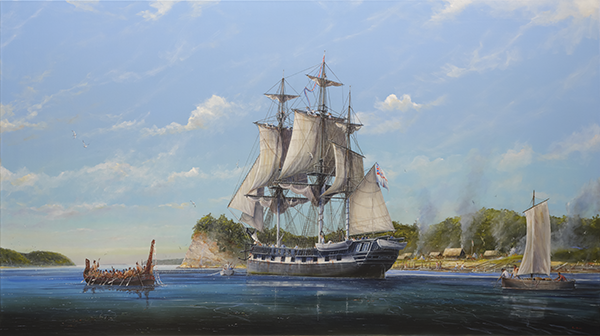
Mobilisation Versus Free Market: The arrival of the hmss Buffalo in its “bay where no ships have been”, scuttled the prospects for the Mahurangi Harbour for becoming the Auckland region’s earliest surviving Pākehā settlement. While Gordon Browne—the putative brother of the illustrious Charles Dickens illustrator “Phiz” Hablot Knight Browne—was establishing his spar station for the purpose of supplying the Admiralty with kauri for topmasts, its storeship Buffalo arrived and helped itself to the Māori workforce assembled, and the pick of the readily reached kauri trees.
marine artist Paul Deacon
To fund the marquee upfront, new members of the Mahurangi marine industries group are supporting the regatta for 10 years, in two instalments one year apart. This—an at-least-semi-plausible 10-year budget indicates—pans out, provided additional sponsor-group members are progressively brought aboard during the first 10 years. Visiting yacht and boating club contributions averaging $150 each annually, will be similarly invited in advance, in two instalments, to support the marquee purchase. Individual regatta goers, on Saturday 27 January, will also be invited to contribute, in exchange for a ⅙-scale keepsake print of the hmss Buffalo off Spar Station Cove.
In a word, the Mahurangi Regatta is unique, and that uniqueness is worth every ounce of effort to preserve. Placing a deposit on a brand-new marquee, even as the global financial system defies gravity and all rationality, might be seen, by the average committee, as the epitome of fiscal irresponsibility. But nor is Mahurangi Action about to embark on its 50th year, apologising.
Further self-funding marquee opportunities from the immediately applicable, to the longer-term:
- Book and pay now, for a future marquee function at Mahurangi West Hall
- Book and pay now, for future marquee function, anywhere
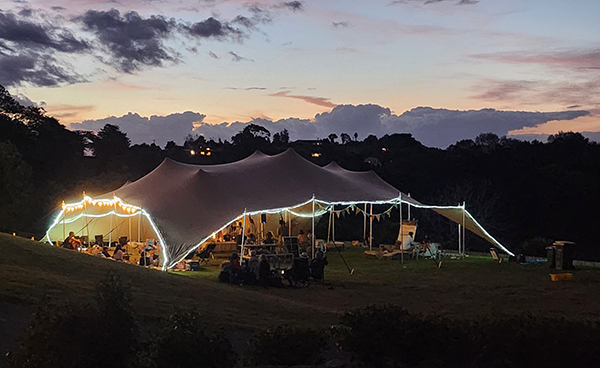
Mahurangi Style: Hard on the heels of the Mahurangi Regatta, the new Mahurangi Harbour community marquee saved the day for the inaugural Mahu West Summer Fest, which otherwise hadn’t enjoyed sufficient ticket sales by marquee-deposit crunch time to proceed, otherwise.
image Mike Neil
- Marquee koha hmss Buffalo off Spar Station Cove keepsake prints, at regatta, or mailed on
- Koha, morning-after-the-night-before Scotts Landing breakfast
- A short, Scotts Landing ‘weddingor other, marquee-suited celebration season’, following the regatta.
- Book and pay now, for future marquee function, anywhere, anytime.
Self-funding marquee footnote So much for self-funding suggestions one to six, above. In the event, the sentiment accompanying a contribution that has resonated most strongly was succinctly supplied by a Mahurangi Action committee member and former commodore of the host yachting club:
Thanks Cimino, I will put in $500 as a deposit on use of marquee for my funeral.
Thus:
- $500 deposit on use of marquee for contributor’s funeral
- $550 deposit on use of marquee for contributor’s funeral including framed certificate attesting to said deposit, bearing Mahurangi Action’s charitable trust number.

Any surplus serendipitous: Should the not-for-profit Mahu West Summer Fest produce a surplus—a far-from forgone conclusion without a goodhearted response to this plea—it will go to the new Mahurangi Harbour community marquee.
image Mahu West Summer Fest
Self-funding funeral deposits Mahurangi Action Incorporated account:
38-9012-0357788-00
A receipted invoice, with registered charity number, will be emailed—please ensure first and last name are included in the particulars, code, or reference. If you are unsure whether Mahurangi Action has your email address, please email “treasurer” at the domain name atop this page.
Stop the self-funding funeral presses Serendipitously, simultaneously with the emergence above of the ‘Peter Oxborough Principle’, the Mahu West Summer Fest was announced. Organiser Nick Carnachan immediately embraced the synergy of the events and pledged the entire proceeds of his initiative:
- All surplus from $65 pp ticket price in the event, $1000 wentgoes to repay Mahurangi Harbour community marquee loans, made by locals.
Marquee funding update In addition to the $32 500 loaned by members to Mahurangi Action Incorporated, a further $10330 has been donated to the regatta–community marquee cause, or deposited towards future private hires. While entirely encouraging, with the cost of the marquee almost $36 500, this is still seriously short of what is required ahead of the 2025 Mahurangi Regatta.
Further footnotes fancy-free Below are footnotes of sometimes only tortuously tangential significance to the main article:
Second life for Supie Deliveries from the heroic startup Supie were yet not available to the Mahurangi Harbour community, by the time of its demise. Setting that small detail aside, as an exercise in defining the potential of the moonbeams moonshot campaign concept expounded in the previous two articles, Supie, conceivably, could have continued trading, had New Zealanders been facilitated to ride to the rescue of the struggling start-up.
New Zealand’s so-called supermarket duopoly problem has so-far proved to be intractable. But to fancy that suddenly, after four decades39 years, dated from the 1984 election, of the Fourth Labour Government, a touch of neoliberal tweaking will see fair prices paid to suppliers and charged to customers is, at best, ideological faith-based-economics daydreaming. Meantime, the poor have the most miserable time of it, particularly the clearly blameless children who go hungry. For a country that has long fancied that it substantively helped feed the world, to fail to feed its own children is as forlorn as it is unforgivable.
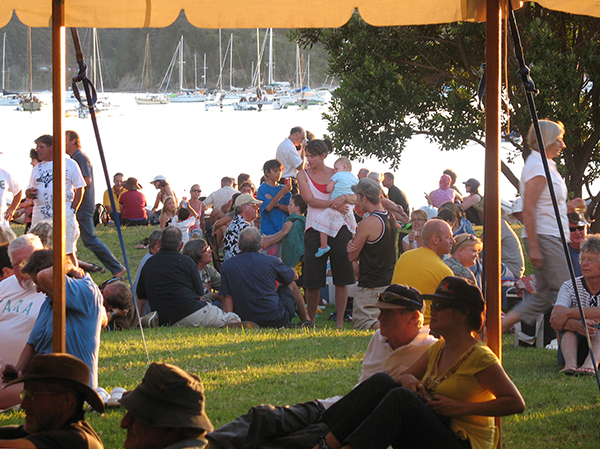
Mellow Chino: Not only is the form of the marquee on order sublime, but, rather than being stark white, is to be a mellow chino, reminiscent of the marquees hired for the first Mahurangi Regatta prize-giving dances, following their revival in 2004. Pictured is the 2008 regatta after-match function, shortly before the Prohibition Big Band—predecessor of the West City Jazz Orchestra—struck up, and had everybody on their feet.
photographer Sarah Ransom
The moonbeams-moonshot concept was also devised with buycott organising in mind. Far less negative than its boy cott flip-side, buycott, in the context of the enduring supermarket monopoly of the supply chain, could provide a pathway to ending profiteering and alleviating food poverty. However, for Supie to compete with the duopoly on the characteristically unlevel neoliberal playing field, suggests, amongst other strategies, taking a leaf out of Sanitarium’s book: Don’t pay taxes. Supie’s successor, as a registered charitable trust, could resist the corrosive imperative to maximise returns to investors, to the mortal detriment of the enterprise. Public ownership, amongst myriad opportunities, would permit pairs of volunteers to lead useful, engaged lives as part-time deliverers.
Even the less-than excessively cynical might be inclined to dismiss the notion that there is a public appetite for a game-changing not-for-profit online-only New Zealand supermarket. However, the fact that “an anonymous and substantial cash contribution” has been forthcoming to pay the wages outstanding when Supie submitted to voluntary receivership might reasonably be taken as admiration for what Sarah Balle and her team were attempting. Sarah Balle, supposing she has anything left in the tank, could be the very person to explain to New Zealanders why waiting for Rogernomics-by-any-other-odious-name to deliver fair prices is delusional. As for the supposed solution of breaking up the duopoly, any breaking up contemplated should be in the style of ship-breaking—scrapping and recycling the model that that only made sense in the brief era that urban reliance on private-light-vehicle transportation remained remotely rational:
It is widely perceived that the electrification of vehicles will be some kind of panacea. But while this is likely to reduce our consumption of fossil fuels, it is unlikely to solve our congestion problems or our dependence on car ownership. In fact, electric vehicles could make things worse. Electrification might make driving more affordable and therefore encourage more of us to drive further—for instance, to move further away from the cities and make longer commutes to work.
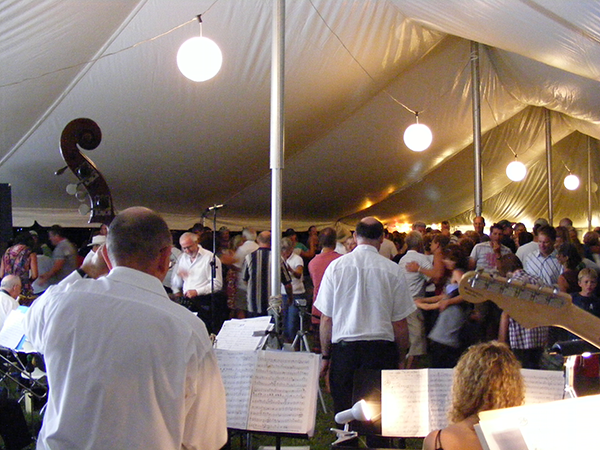
Seeing Out the Problem: Low-sided marquees of the standard type used until now for the Mahurangi Regatta prize-giving dance, visually separate the enclosed area from the sea of riding lights immediately offshore, and from the al fresco dancers between the marquee and foreshore. When Teak Construction finally got the jazz orchestra up off the grass onto a low bandstand, the harbour view, particularly for the horn-playing back row of musicians, was even further eclipsed. The Stretch Tents marquee on order, addresses this issue with alacrity.
photographer Jason Brown
With Earth systems already flickering ominously, it is beyond urgent that cynicism is side-lined. Building the low-carbon food distribution infrastructure that both the climate emergency and ending child poverty demands, ticks too many big-box-store-antidote boxes to enumerate in this footnote, and , as Picnic appears to be proving on an entirely for-profit basis in the Netherlands, could hasten an end to private-light-vehicle dependency.
Mobilising end of post-neoliberal interregnum, now! Setting aside the question as to whether the reign of neoliberalism has indeed ended—it apparently hasn’t in the eyes of the steadfastly unrepentant New Zealand Labour Party—the notion that yet another economic doctrine must follow the failed, zombie neoliberal one, is vacuous. That goes for the stillborn Green New Deal; war—or at least, mobilisation—is what finally worked for the United States, not New Deal economics. After frittering away four decades, how any aspiring world leader can imagine that the beyond-urgent climate action needed, at pace and at scale, can be achieved without planning and mobilisation defies comprehension.
That there is time for interregnum navel-gazing, while multiple Earth systems flicker, indicates that no country is demonstrating what a climate emergency looks like. Notions like sustainability are nonsense when civilisation’s existential imperative is survival. Sustainability, for example, would have been a wonderful policy to pursue, per se, earlier in the process of plundering the planet’s fossil-fuel reserves. That energy, now, must be renewable is taken unquestioningly as a given. If there was adequate communication as to the global warming in the pipeline, rather than renewable, a catchphrase for low-carbon-and-massively-scalable would be on everybody’s lips—as with so much in life, climate is is complicated. So perhaps, catchier than Green New Deal: Real Deal. Better yet, given that this must be the mother of them all: Mobilisation. Simple, five-syllable sufficiency, and to ensure there is no ambiguity, the mobilisation of nations to make war on their neighbours must be immediately ended—by the global parliamentary assembly that the people who survived World War II should have insisted upon.
Speaking of capital (ism) Questioning whether the neoliberalism has reached its interregnum is one thing. Yanis Varoufakis is way beyond that, declaring that capitalism is dead, supplanted by technofeudalism. Capitalism might have emerged half a millennium ago, but civilisation is 30 times older than that, and Homo sapiens sapiensas opposed to Homo sapiens, to acknowledge Homo sapiens idaltu, and to avoid the more cumbersome alternative of ‘anatomically modern human being’, and for sheer cussedness, 600 times older. Given that current global climate heating could render civilisation unrecognisable this century, it is clearly not unreasonable to entertain alternative economic systems. Mobilisation, by the most urgent and effective means humanity can muster, is axiomatic—or long since would have been self-evident, was it not for the inherently flawed structure of the ipcc. Very possibly, Dr Varoufakis’ proposal to democratise money will need to be part of mobilisation, but unless humanity does mobilise, all other reforms are academic.
Mahurangi never a capital idea It is true that the acting-Surveyor General Felton Mathew visited the Mahurangi Harbour on his way from Ōkiato—which was briefly serving as the colony’s capital—to Tāmaki Makauraute reo Māori for Auckland isthmus. However, when Mathew reported on the Mahurangi Harbour’s suitability or otherwise as the capital of New Zealand, it was by way of completeness—he also reported on the suitability of Whangārei Harbour. Waitematā Harbour was always the more likely port for the dominion’s first, deliberate capital:
My chief objections are that [the Mahurangi Harbour] is rather limited in extent, internal communication would be rather difficult and its position is somewhat too far northward.
Disclosure The author of this article is the secretary of both Mahurangi Action Incorporated and the Mahurangi Coastal Path Trust, and has voted Māori, more than once—although the particularly stringent strategic-voting demanded, in 2023, that Green be supported, heavily outweighed any lesser-of-two-neoliberal-evils usefulness of voting for that which masqueraded as Red. The article published here, meantime, is that of the editorially independent, independently funded Mahurangi Magazine.
 1 2 3 fix mmp
About, about…
Annual report
chart competition
Climate-action mobilisation
hmss Buffalo
Jade River: A History of the Mahurangi
Mahurangi Action Inc.
Mahurangi Action Plan
Mahurangi Coastal Path
Mahurangi Gallery
Mahurangi Magazine
Mahurangi Regatta
Open-ground indigenous plants establishment trials
Regional parkland
Watermills, millraces, dams and weirs
1 2 3 fix mmp
About, about…
Annual report
chart competition
Climate-action mobilisation
hmss Buffalo
Jade River: A History of the Mahurangi
Mahurangi Action Inc.
Mahurangi Action Plan
Mahurangi Coastal Path
Mahurangi Gallery
Mahurangi Magazine
Mahurangi Regatta
Open-ground indigenous plants establishment trials
Regional parkland
Watermills, millraces, dams and weirs






